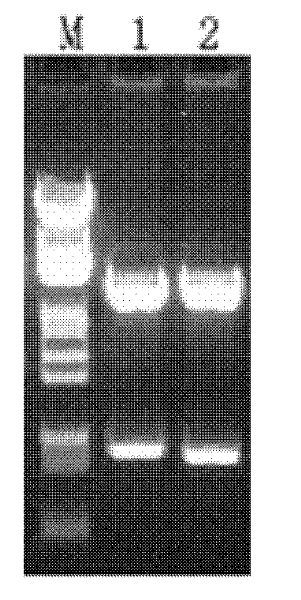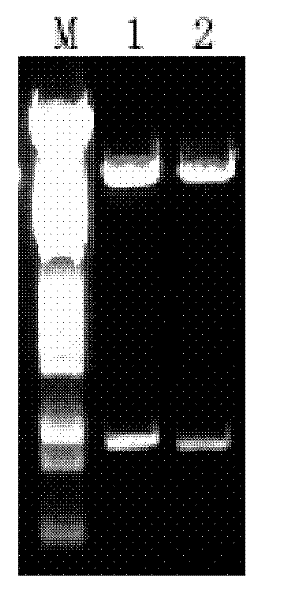Polyclonal antibody against outer membrane protein of Candidatus liberobacter asiaticum, and preparation method and application thereof
A technology of citrus Huanglongbing bacteria and polyclonal antibody, which is applied in the field of genetic engineering to achieve the effects of shortening the production cycle, increasing yield and purity, and improving efficiency
- Summary
- Abstract
- Description
- Claims
- Application Information
AI Technical Summary
Problems solved by technology
Method used
Image
Examples
Embodiment 1
[0032] Embodiment 1 Amplification of outer membrane protein gene and construction of expression vector
[0033] 1. Design and synthesis of specific primers
[0034] Using bioinformatics software to analyze the outer membrane protein gene sequence of Huanglongbing citri, design specific primers for specific amplification of the N-terminal of the gene: OMPN5: 5′-AGCGGATCCCAATTGAAGATGATAGTTCGCT-3′ and OMPN3: 5′-AGCAAGCTTTTACACATAATCGGATACATCAT-3′, using Primers OMPC5 at the C-terminus of the amplified gene: 5′-AGCGGATCCTATTTTTAGGGAGTCCTATATC-3′ and OMPC3: 5′-AGCAAGCTTTTACATGCGATTACCTATACG-3′, the designed primers were sent to the company for synthesis.
[0035] 2. Extraction of total DNA from citrus leaves
[0036] Collect citrus leaves infected by citrus Huanglongbing bacteria in the field, take the midrib of the leaves and weigh about 0.1-0.2g, grind them into powder with liquid nitrogen in a sterile mortar, add appropriate amount of PVP and mercaptoethanol, and extract with t...
Embodiment 2
[0045] Example 2 Induced expression and separation and purification of outer membrane protein
[0046] 1. Induced expression of outer membrane proteins
[0047] Using CaCl 2 Escherichia coli BL21 competent cells were prepared by the above method, and the above-mentioned recombinant plasmids pIGH3-OMP-N and pIGH3-OMP-C were transformed into competent cells respectively, and the transformed products were coated on LB medium plates, and cultured at 37°C until colonies grew out. . Pick the monoclonal colony on the plate, shake culture in LB liquid medium, add 0.5mM IPTG to induce the expression of the target protein in the logarithmic growth phase (OD600 is 0.5-0.6), and perform SDS-PAGE electrophoresis on the expressed product, Detection of protein expression. The result shows that there are specific bands with a size of about 58KD and 55KD in the induced bacterial protein (see attached Figure 5 ), consistent with the expected target protein size.
[0048] 2. Separation and...
Embodiment 3
[0050] Example 3 Preparation and Purification of Outer Membrane Protein Polyclonal Antibody
[0051] 1. Antiserum preparation and potency determination
[0052]Take 500 μg of OMP-N protein and OMP-C protein respectively, supplement it with PBS to 500 μL, add an equal amount of Freund’s complete adjuvant, emulsify for 3 times, inject into white rabbits subcutaneously (take negative serum before immunization), and inject 250 μg of protein 2 weeks later. / 500μL protein plus the same amount of Freund's incomplete adjuvant to boost the immunization, and then 250ug / 500ul protein plus the same amount of Freund's incomplete adjuvant to boost the immunization after 5 weeks and 8 weeks respectively, sacrifice the white rabbits in the 10th week, and extract the anti- serum. Coat OMP-N protein and OMP-C protein on the microtiter plate respectively, dilute negative serum at 1:1000 and 1:4000, and dilute positive antiserum at 1:1000, 1:4000, 1:16000, 1:32000 , 1:64000, 1:128000 dilution, ...
PUM
 Login to View More
Login to View More Abstract
Description
Claims
Application Information
 Login to View More
Login to View More - R&D
- Intellectual Property
- Life Sciences
- Materials
- Tech Scout
- Unparalleled Data Quality
- Higher Quality Content
- 60% Fewer Hallucinations
Browse by: Latest US Patents, China's latest patents, Technical Efficacy Thesaurus, Application Domain, Technology Topic, Popular Technical Reports.
© 2025 PatSnap. All rights reserved.Legal|Privacy policy|Modern Slavery Act Transparency Statement|Sitemap|About US| Contact US: help@patsnap.com



